Determination of Acceptable Quality Limit for Casting of A356 Aluminium Alloy: Supplier’s Quality Index (SQI)
Abstract
1. Introduction
2. Experimental
3. Results and Discussion
4. Conclusions
Author Contributions
Funding
Acknowledgments
Conflicts of Interest
References
- Campbell, J. Complete Casting Handbook: Metal Casting Processes, Metallurgy, Techniques and Design; Elsevier Science: Kidlington, UK, 2015. [Google Scholar]
- Liu, S.G.; Cao, F.Y.; Zhao, X.Y.; Jia, Y.D.; Ning, Z.L.; Sun, J.F. Characteristics of mold filling and entrainment of oxide film in low pressure casting of A356 alloy. Mater. Sci. Eng. A 2015, 626, 159–164. [Google Scholar] [CrossRef]
- Campbell, J. Entrainment defects. Mater. Sci. Technol. 2006, 22, 127–145. [Google Scholar] [CrossRef]
- Dispinar, D.; Campbell, J. Critical assessment of reduced pressure test. Part 2: Quantification. Int. J. Cast Met. Res. 2004, 17, 287–294. [Google Scholar] [CrossRef]
- Dispinar, D.; Campbell, J. Critical assessment of reduced pressure test. Part 1: Porosity phenomena. Int. J. Cast Met. Res. 2004, 17, 280–286. [Google Scholar] [CrossRef]
- Dispinar, D.; Campbell, J. Use of bifilm index as an assessment of liquid metal quality. Int. J. Cast Met. Res. 2006, 19, 5–17. [Google Scholar] [CrossRef]
- Dispinar, D.; Campbell, J. Effect of casting conditions on aluminium metal quality. J. Mater. Process. Technol. 2007, 182, 405–410. [Google Scholar] [CrossRef]
- Dispinar, D.; Campbell, J. Reduced Pressure Test (RPT) for Bifilm Assessment. In Proceedings of the 5th International Symposium 2014; John Wiley & Sons: Hoboken, NJ, USA, 2013. [Google Scholar]
- Maijer, D.; Owen, W.; Vetter, R. An investigation of predictive control for aluminum wheel casting via a virtual process model. J. Mater. Process. Technol. 2009, 209, 1965–1979. [Google Scholar] [CrossRef]
- Avalle, M. Casting defects and fatigue strength of a die cast aluminium alloy: A comparison between standard specimens and production components. Int. J. Fatigue 2002, 24, 1–9. [Google Scholar] [CrossRef]
- Dispinar, D.; Akhtar, S.; Nordmark, A.; Di Sabatino, M.; Arnberg, L. Degassing, hydrogen and porosity phenomena in A356. Mater. Sci. Eng. A 2010, 527, 3719–3725. [Google Scholar] [CrossRef]
- Dispinar, D.; Campbell, J. Porosity, hydrogen and bifilm content in Al alloy castings. Mater. Sci. Eng. A 2011, 528, 3860–3865. [Google Scholar] [CrossRef]
- Li, P.; Maijer, D.; Lindley, T.; Lee, P.; Lee, P. A through process model of the impact of in-service loading, residual stress, and microstructure on the final fatigue life of an A356 automotive wheel. Mater. Sci. Eng. A 2007, 460, 20–30. [Google Scholar] [CrossRef]
- Bozchaloei, G.E.; Varahram, N.; Davami, P.; Kim, S.K. Effect of oxide bifilms on the mechanical properties of cast Al–7Si–0.3Mg alloy and the roll of runner height after filter on their formation. Mater. Sci. Eng. A 2012, 548, 99–105. [Google Scholar] [CrossRef]
- Haberl, K.; Schumacher, P.; Geier, G.; Stauder, B. Characterization of the Melt Quality and Impurity Content of an Lm25 Alloy. Met. Mater. Trans. A 2009, 40, 812–821. [Google Scholar] [CrossRef]
- Gallo, R. Cleaner aluminum melts in foundries: A critical review and update. AFS Trans. 2008, 166, 195–220. [Google Scholar]
- Mostafaei, M.; Ghobadi, M.; Eisaabadi B., G.; Uludağ, M.; Tiryakioğlu, M. Evaluation of the Effects of Rotary Degassing Process Variables on the Quality of A357 Aluminum Alloy Castings. Met. Mater. Trans. A 2016, 47, 3469–3475. [Google Scholar] [CrossRef]
- Haberl, K.; Schumacher, P.; Geier, G.; Stauder, B. Ultrasonic degassing of aluminium alloys: Basic studies and practical implementation. Mater. Sci. Technol. 2015, 31, 79–84. [Google Scholar]
- Fan, Z.Y.; Zuo, Y.B.; Jiang, B. A New Technology for Treating Liquid Metals with Intensive Melt Shearing. Mater. Sci. Forum 2011, 690, 141–144. [Google Scholar] [CrossRef]
- Zuo, Y.B.; Jiang, B.; Zhang, Y.J.; Fan, Z. Degassing LM25 aluminium alloy by novel degassing technology with intensive melt shearing. Int. J. Cast Met. Res. 2013, 26, 16–21. [Google Scholar] [CrossRef]
- Puga, H.; Barbosa, J.; Azevedo, T.; Ribeiro, S.; Alves, J.L. Low pressure sand casting of ultrasonically degassed AlSi7Mg0.3 alloy: Modelling and experimental validation of mould filling. Mater. Des. 2016, 94, 384–391. [Google Scholar] [CrossRef]
- Puga, H.; Barbosa, J.; Seabra, E.; Ribeiro, S.; Prokić, M.; Ribeiro, C.A.S. The influence of processing parameters on the ultrasonic degassing of molten AlSi9Cu3 aluminium alloy. Mater. Lett. 2009, 63, 806–808. [Google Scholar] [CrossRef]
- Puga, H.; Barbosa, J.; Teixeira, J.C.; Prokić, M. A New Approach to Ultrasonic Degassing to Improve the Mechanical Properties of Aluminum Alloys. J. Mater. Eng. Perform. 2014, 23, 3736–3744. [Google Scholar] [CrossRef]
- Yao, L.; Cockcroft, S.; Reilly, C.; Zhu, J. Factors affecting the nucleation kinetics of microporosity formation in aluminum alloy A. Metall. Mat. Trans. A 2012, 43, 1004–1016. [Google Scholar] [CrossRef]
- Raiszadeh, R.; Griffiths, W.D. The effect of holding liquid aluminum alloys on oxide film content. Metall. Mat. Trans. A 2011, 42, 133–143. [Google Scholar] [CrossRef]
- Uludağ, M.; Çetin, R.; Dişpinar, D. Freezing Range, Melt Quality, and Hot Tearing in Al-Si Alloys. Met. Mater. Trans. A 2018, 49, 1948–1961. [Google Scholar] [CrossRef]
- Uludağ, M.; Çetin, R.; Dispinar, D.; Tiryakioğlu, M. Characterization of the Effect of Melt Treatments on Melt Quality in Al-7wt %Si-Mg Alloys. Metals 2017, 7, 157. [Google Scholar] [CrossRef]
- Uludağ, M.; Çetin, R.; Dispinar, D.; Tiryakioğlu, M. Effect of Degassing and Grain Refinement on Hot Tearing Tendency in Al8Si3Cu Alloy. Int. J. Met. 2017, 12, 589–595. [Google Scholar] [CrossRef]
- Uludağ, M.; Çetin, R.; Dişpinar, D.; Tiryakioğlu, M.; Tiryakioǧlu, M. On the Interpretation of Melt Quality Assessment of A356 Aluminum Alloy by the Reduced Pressure Test: The Bifilm Index and Its Physical Meaning. Int. J. Met. 2018, 12, 853–860. [Google Scholar] [CrossRef]
- Bakhtiarani, F.N.; Raiszadeh, R. Healing of Double-Oxide Film Defects in Commercial Purity Aluminum Melt. Met. Mater. Trans. A 2011, 42, 331–340. [Google Scholar] [CrossRef]
- Nateghian, M.; Raiszadeh, R.; Doostmohammadi, H. Behavior of Double-Oxide Film Defects in Al-0.05 wt pct Sr Alloy. Met. Mater. Trans. A 2012, 43, 1540–1549. [Google Scholar] [CrossRef]
- Dos Santos, S.L.; Antunes, R.A.; Santos, S.F. Influence of injection temperature and pressure on the microstructure, mechanical and corrosion properties of a AlSiCu alloy processed by HPDC. Mater. Des. 2015, 88, 1071–1081. [Google Scholar] [CrossRef]
- González, R.; Martínez, D.I.; González, J.A.; Talamantes, J.; Valtierra, S.; Colás, R. Experimental investigation for fatigue strength of a cast aluminium alloy. Int. J. Fatigue 2011, 33, 273–278. [Google Scholar] [CrossRef]
- Lee, K.; Kwon, Y.N.; Lee, S. Effects of eutectic silicon particles on tensile properties and fracture toughness of A356 aluminum alloys fabricated by low-pressure-casting, casting-forging, and squeeze-casting processes. J. Alloy. Compd. 2008, 461, 532–541. [Google Scholar] [CrossRef]
- Lee, K.; Kwon, Y.N.; Lee, S. Correlation of microstructure with mechanical properties and fracture toughness of A356 aluminum alloys fabricated by low-pressure-casting, rheo-casting, and casting–forging processes. Eng. Fract. Mech. 2008, 75, 4200–4216. [Google Scholar] [CrossRef]
- Merlin, M.; Timelli, G.; Bonollo, F.; Garagnani, G.L. Impact behaviour of A356 alloy for low-pressure die casting automotive wheels. J. Mater. Process. Technol. 2009, 209, 1060–1073. [Google Scholar] [CrossRef]
- Miller, A.; Maijer, D. Investigation of erosive-corrosive wear in the low pressure die casting of aluminum A. Mater. Sci. Eng. A 2006, 435, 100–111. [Google Scholar] [CrossRef]
- Teng, X.; Mae, H.; Bai, Y.; Wierzbicki, T. Pore size and fracture ductility of aluminum low pressure die casting. Eng. Fract. Mech. 2009, 76, 983–996. [Google Scholar] [CrossRef]
- Yuksel, C.; Tamer, O.; Erzi, E.; Aybarc, U.; Cubuklusu, E.; Topcuoglu, O.; Cigdem, M.; Dispinar, D. Quality Evaluation of Remelted A356 Scraps. Arch. Foundry Eng. 2016, 16, 151–156. [Google Scholar] [CrossRef]
- Zhang, B.; Maijer, D.; Cockcroft, S. Development of a 3-D thermal model of the low-pressure die-cast (LPDC) process of A356 aluminum alloy wheels. Mater. Sci. Eng. A 2007, 464, 295–305. [Google Scholar] [CrossRef]
- Lee, C.D. Effect of T6 heat treatment on the defect susceptibility of fatigue properties to microporosity variations in a low-pressure die-cast A356 alloy. Mater. Sci. Eng. A 2013, 559, 496–505. [Google Scholar] [CrossRef]
- Cáceres, C.H. A rationale for the quality index of Al-Si-Mg casting alloys. Int. J. Cast Met. Res. 1998, 10, 293–299. [Google Scholar] [CrossRef]
- Cáceres, C.H. A phenomenological approach to the Quality Index of Al-Si-Mg casting alloys. Int. J. Cast Met. Res. 2000, 12, 367–375. [Google Scholar] [CrossRef]
- Caceres, C. Microstructure Design and Heat Treatment Selection for Casting Alloys Using the Quality Index. J. Mater. Eng. Perform. 2000, 9, 215–221. [Google Scholar] [CrossRef]
- Cáceres, C.; Barresi, J. Selection of temper and Mg content to optimise the Quality Index of Al-7Si-Mg casting alloys. Int. J. Cast Met. Res. 2000, 12, 377–384. [Google Scholar] [CrossRef]
- Caceres, C.; Din, T.; Rashid, A.; Campbell, J. Effect of aging on quality index of an Al–Cu casting alloy. Mater. Sci. Technol. 1999, 15, 711–716. [Google Scholar] [CrossRef]
- Cáceres, C.; Makhlouf, M.; Apelian, D.; Wang, L.; Cáceres, C. Quality index chart for different alloys and temperatures: A case study on aluminium die-casting alloys. J. Light Met. 2001, 1, 51–59. [Google Scholar] [CrossRef]
- Alexopoulos, N. Generation of quality maps to support material selection by exploiting the quality indices concept of cast aluminum alloys. Mater. Des. 2007, 28, 534–543. [Google Scholar] [CrossRef]
- Alexopoulos, N.D.; Pantelakis, S.G. Quality assessment of artificially aged A357 aluminum alloy cast ingots by introducing approximate expressions of the quality index Q D. Met. Mater. Trans. A 2004, 35, 3079–3089. [Google Scholar] [CrossRef]
- Alexopoulos, N.D.; Pantelakis, S.G. A new quality index for characterizing aluminum cast alloys with regard to aircraft structure design requirements. Met. Mater. Trans. A 2004, 35, 301–308. [Google Scholar] [CrossRef]
- Alexopoulos, N.; Pantelakis, S. Quality evaluation of A357 cast aluminum alloy specimens subjected to different artificial aging treatment. Mater. Des. 2004, 25, 419–430. [Google Scholar] [CrossRef]
- Tiryakioğlu, M.; Campbell, J. Quality Index for Aluminum Alloy Castings. Int. J. Met. 2014, 8, 39–42. [Google Scholar] [CrossRef]
- Tiryakioğlu, M.; Campbell, J.; Alexopoulos, N.D. On the Ductility of Cast Al-7 Pct Si-Mg Alloys. Met. Mater. Trans. A 2009, 40, 1000–1007. [Google Scholar] [CrossRef]
- Tiryakioğlu, M.; Staley, J.T.; Campbell, J. Evaluating structural integrity of cast Al–7% Si–Mg alloys via work hardening characteristics: II. A new quality index. Mater. Sci. Eng. A 2004, 368, 231–238. [Google Scholar] [CrossRef]
- Di Sabatino, M.; Arnberg, L.; Rørvik, S.; Prestmo, A. The influence of oxide inclusions on the fluidity of Al–7wt. %Si alloy. Mater. Sci. Eng. A 2005, 413, 272–276. [Google Scholar] [CrossRef]
- Di Sabatino, M.; Syvertsen, F.; Arnberg, L.; Nordmark, A. An improved method for fluidity measurement by gravity casting of spirals in sand moulds. Int. J. Cast Met. Res. 2005, 18, 59–62. [Google Scholar] [CrossRef]
- Liu, L.; Samuel, F. Effect of inclusions on the tensile properties of Al–7% Si–0.35% Mg (A356.2) aluminium casting alloy. J. Mater. Sci. 1998, 33, 2269–2281. [Google Scholar] [CrossRef]
- Chiesa, F.; Mammen, J. Correlating Microporosity to Local Solidification Conditions and RPT in Aluminum A356 Castings (99-18). Trans. Am. Foundrymen’s Soc. 1999, 107, 103–112. [Google Scholar]
- DasGupta, B.; Parmenter, L.; Apelian, D. Relationship between the Reduced Pressure Test and Hydrogen Content of the Melt. In Proceedings of the 5th International Conference on Molten Metal Processing, Orlando, FL, USA, 8–10 November 1998. [Google Scholar]
- LaOrchan, W.; Mulazimoglu, M.; Gruzleski, J. Constant volume risered mold for reduced pressure test. AFS Trans. 1994, 101, 253–259. [Google Scholar]
- DeWeese, S.; Atkinson, R.; Rasmussen, W. RPT measures hydrogen gas, effects on casting quality. Mod. Cast. 1992, 82, 29–31. [Google Scholar]
- Samuel, A.M.; Doty, H.W.; Valtierra, S.; Samuel, F.H. Inclusion Measurements in Al–Si Foundry Alloys Using Qualiflash and Prefil Filtration Techniques. Int. J. Met. 2018, 12, 625–642. [Google Scholar] [CrossRef]
- Samuel, A.M.; Doty, H.W.; Valtierra, S.; Samuel, F.H. Metallurgical Aspects of Inclusion Assessment in Al–6%Si Casting Alloy Using the LiMCA Technique. Int. J. Met. 2018, 12, 643–657. [Google Scholar] [CrossRef]
- Hudson, S.W.; Apelian, D. Inclusion Detection in Molten Aluminum: Current Art and New Avenues for In Situ Analysis. Int. J. Met. 2016, 10, 289–305. [Google Scholar] [CrossRef]
- Dispinar, D.; Nordmark, A.; Syvertsen, F. Melt Cleanliness, Hydrogen Content and Tensile Properties of A356. In Proceedings of the Shape Casting; Wiley: Hoboken, NJ, USA, 2011; pp. 173–180. [Google Scholar]
- Yorulmaz, A.; Erzi, E.; Gursoy, O.; Dispinar, D. End product rejection rate and its correlation with melt treatment in direct-chill casted hot rolling slabs. Int. J. Cast Met. Res. 2019, 32, 164–170. [Google Scholar] [CrossRef]
- Drouzy, M.; Jacob, S.; Richard, M. Interpretation of tensile results by means of quality index and probable yield strength-application to Al-Si7 Mg foundry alloys-France. Int. Cast Met. J. 1980, 5, 43–50. [Google Scholar]
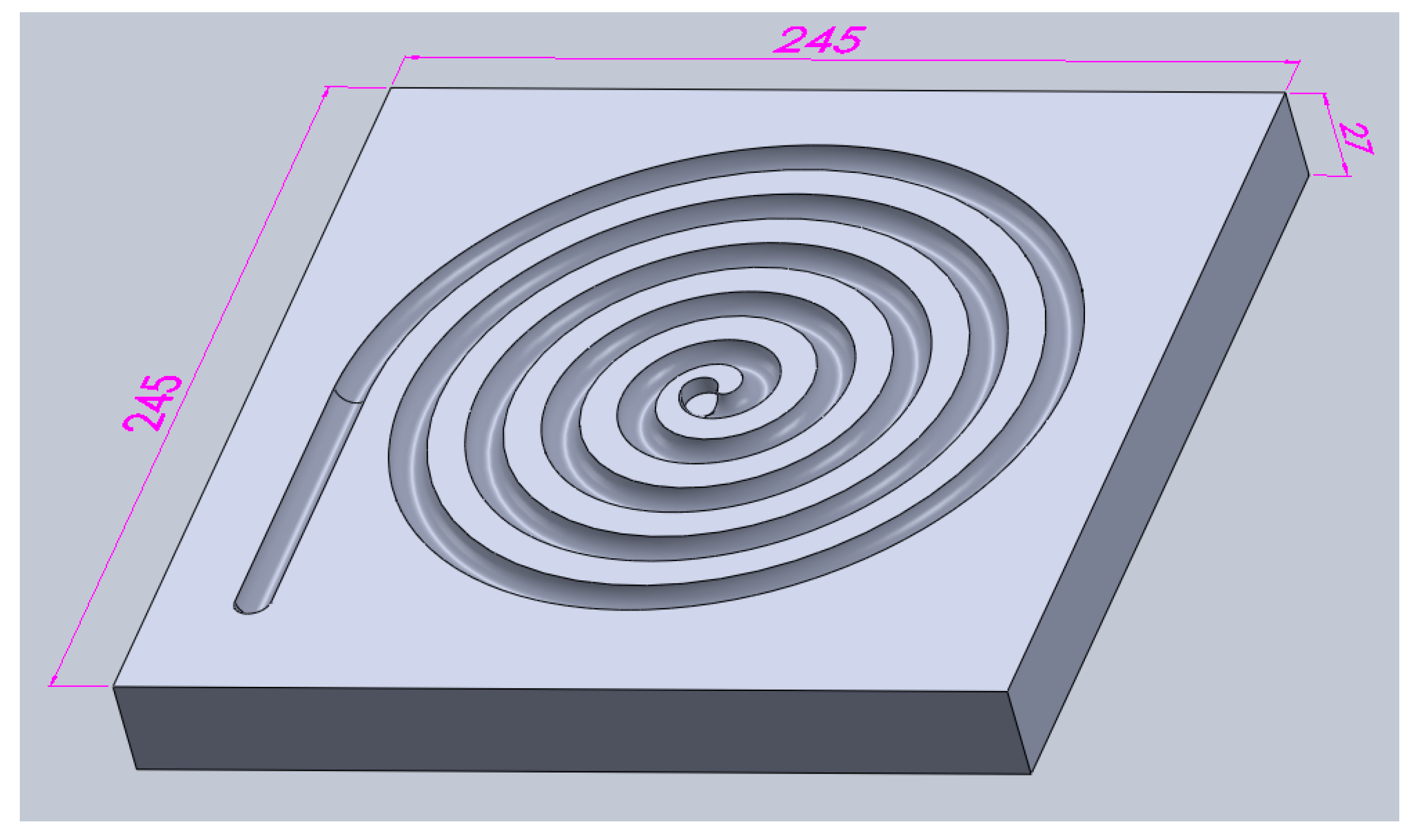
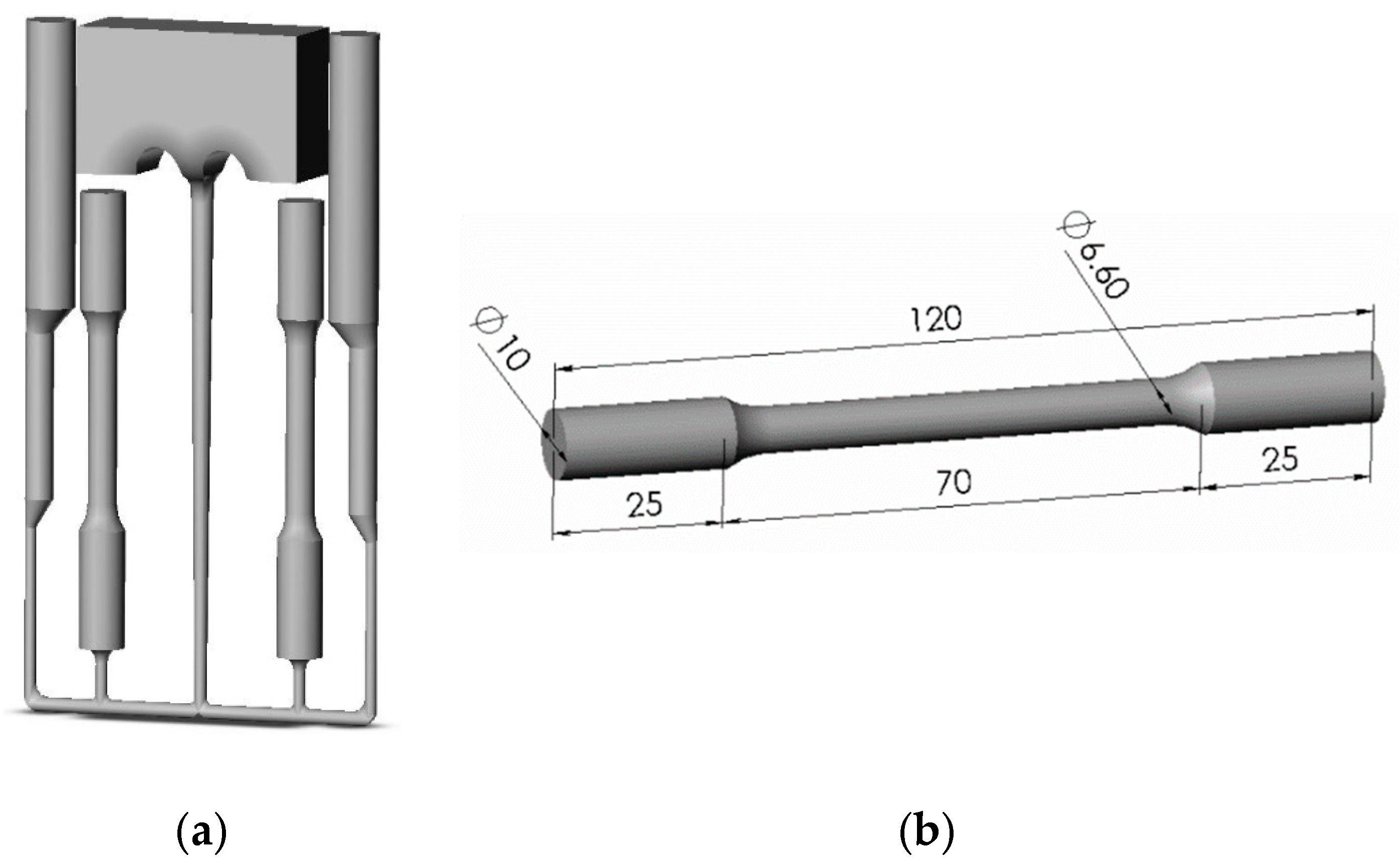
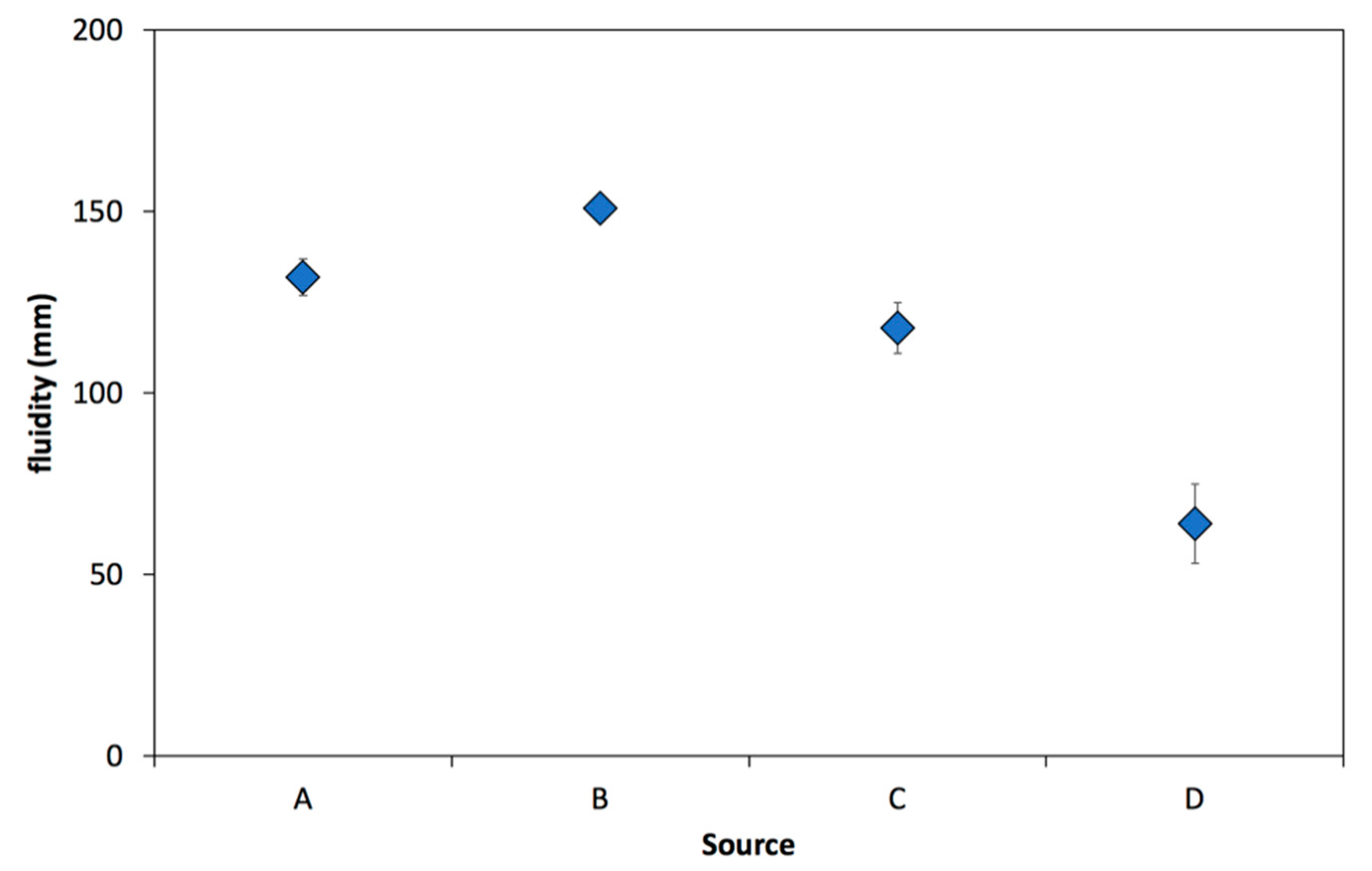
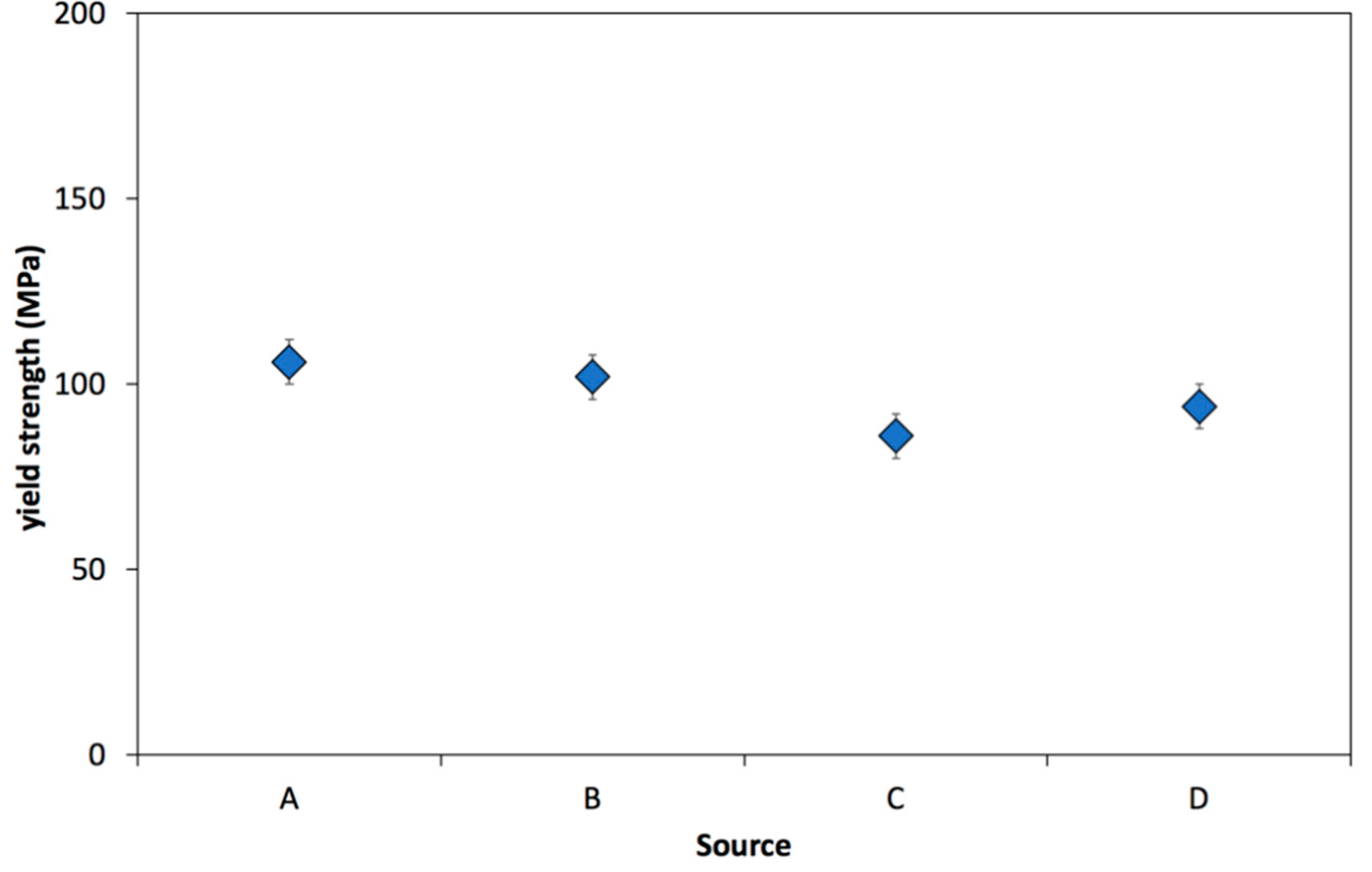
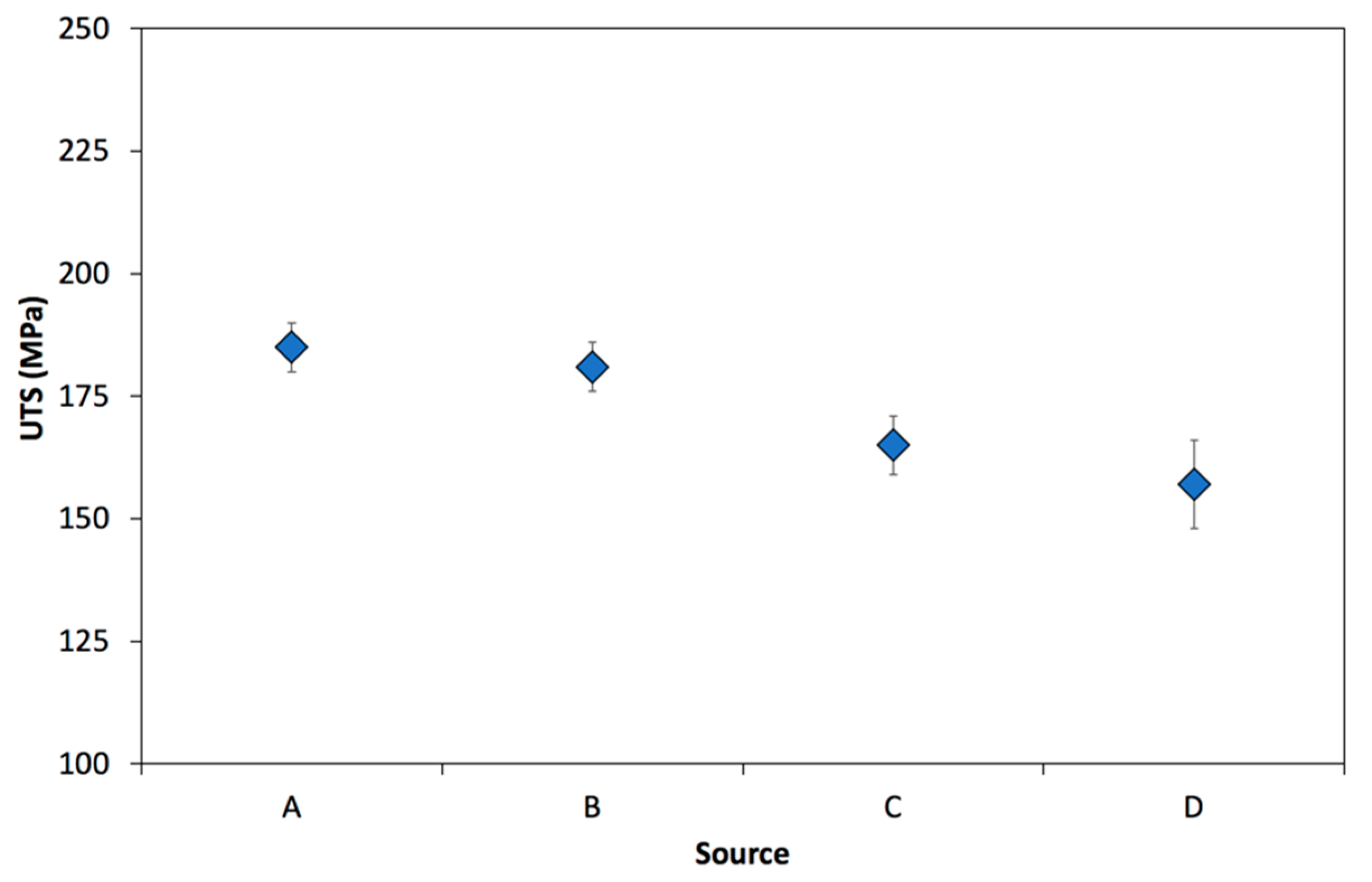

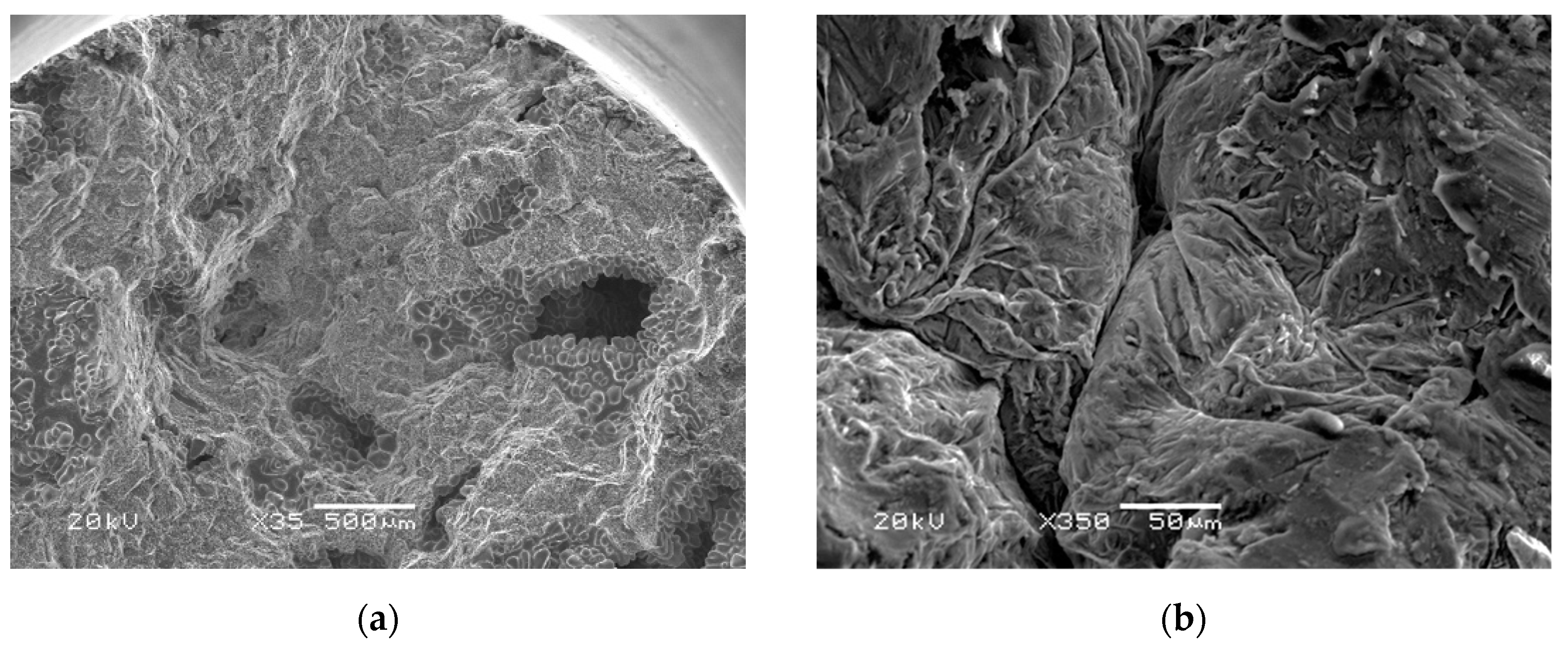
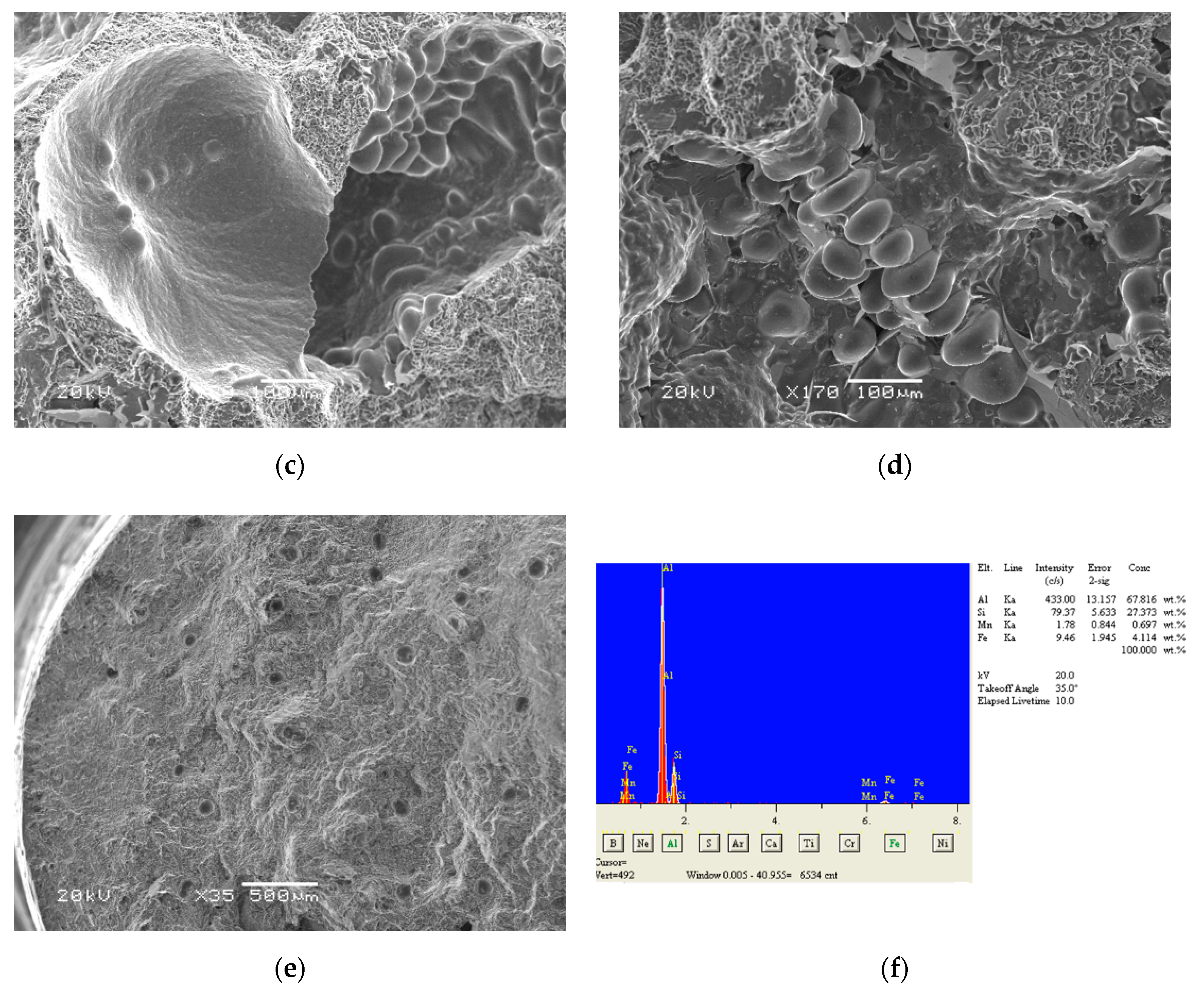

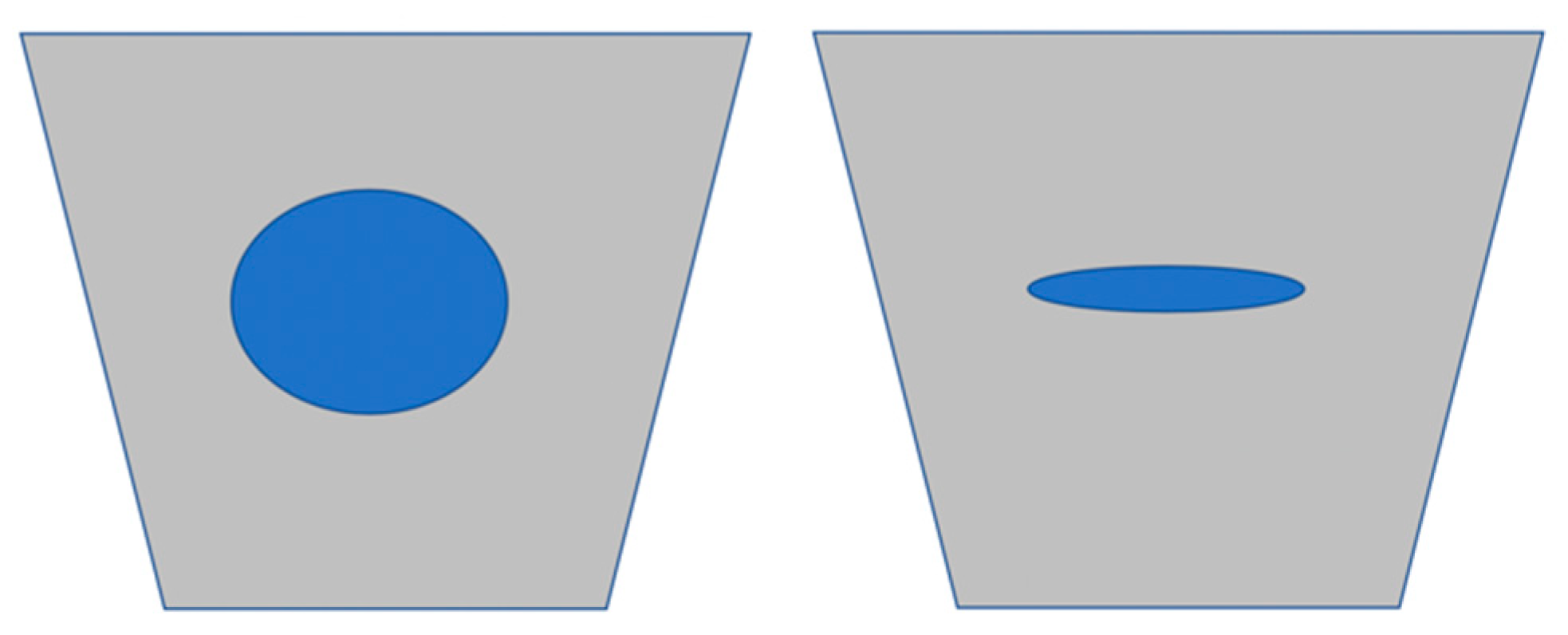
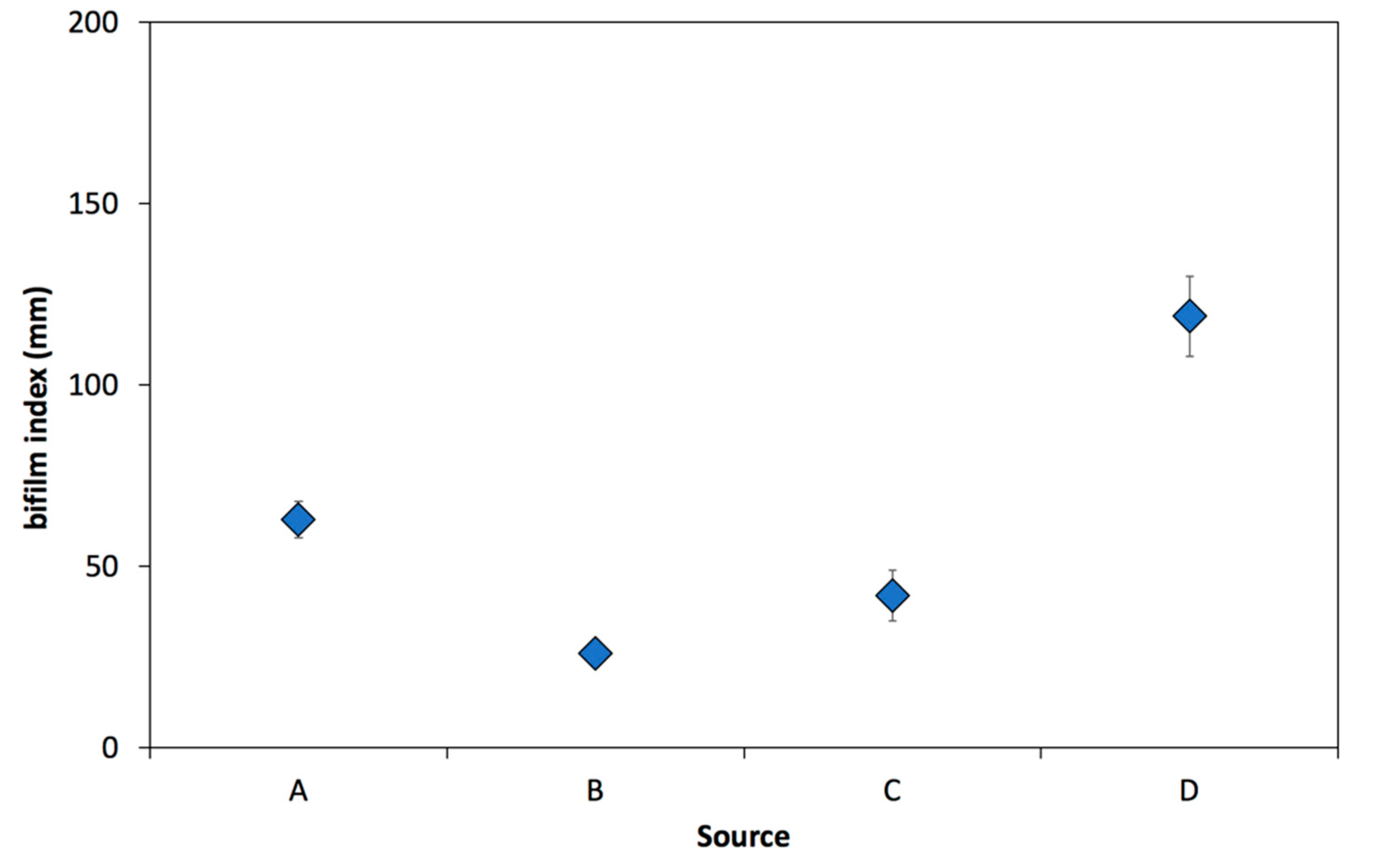

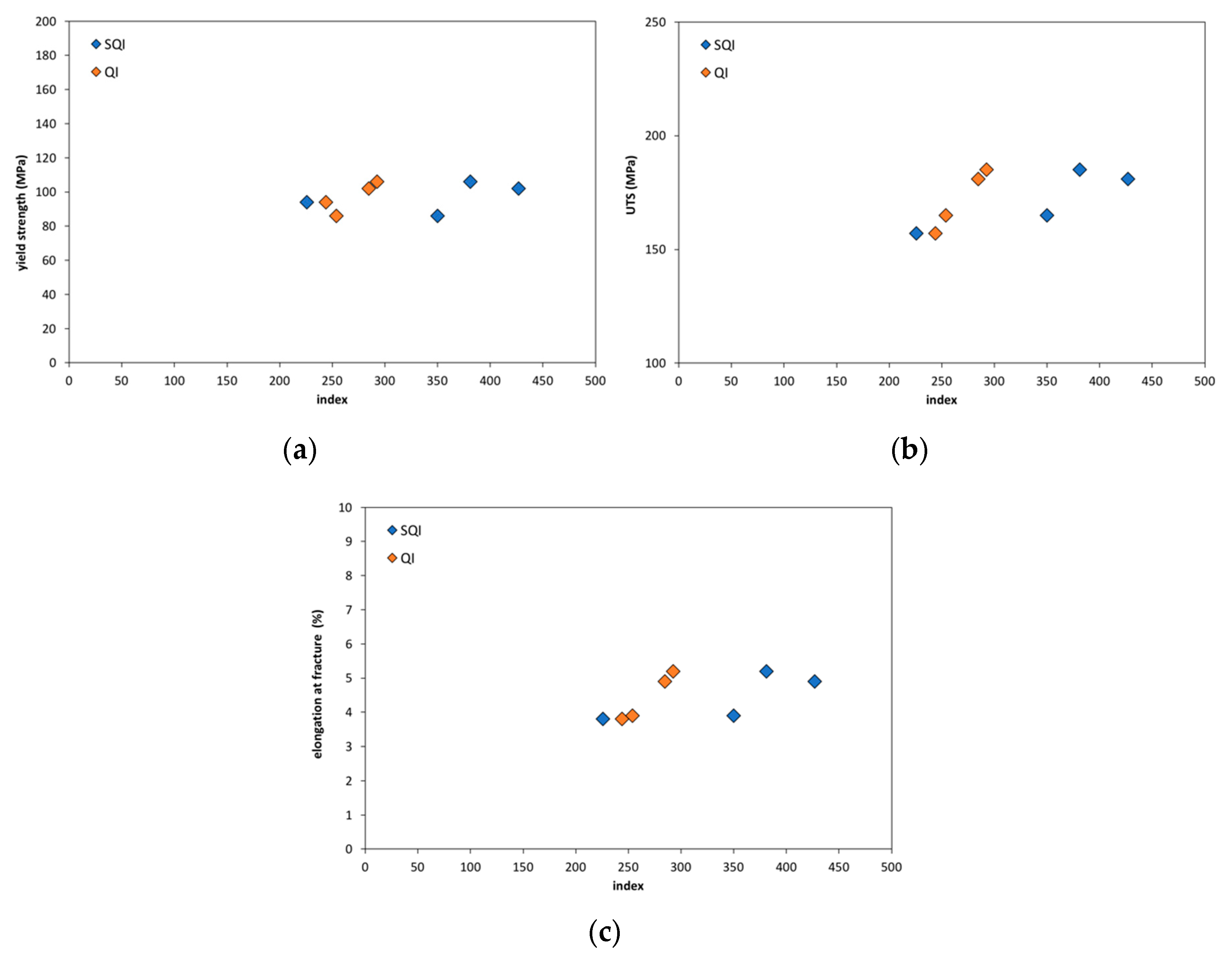
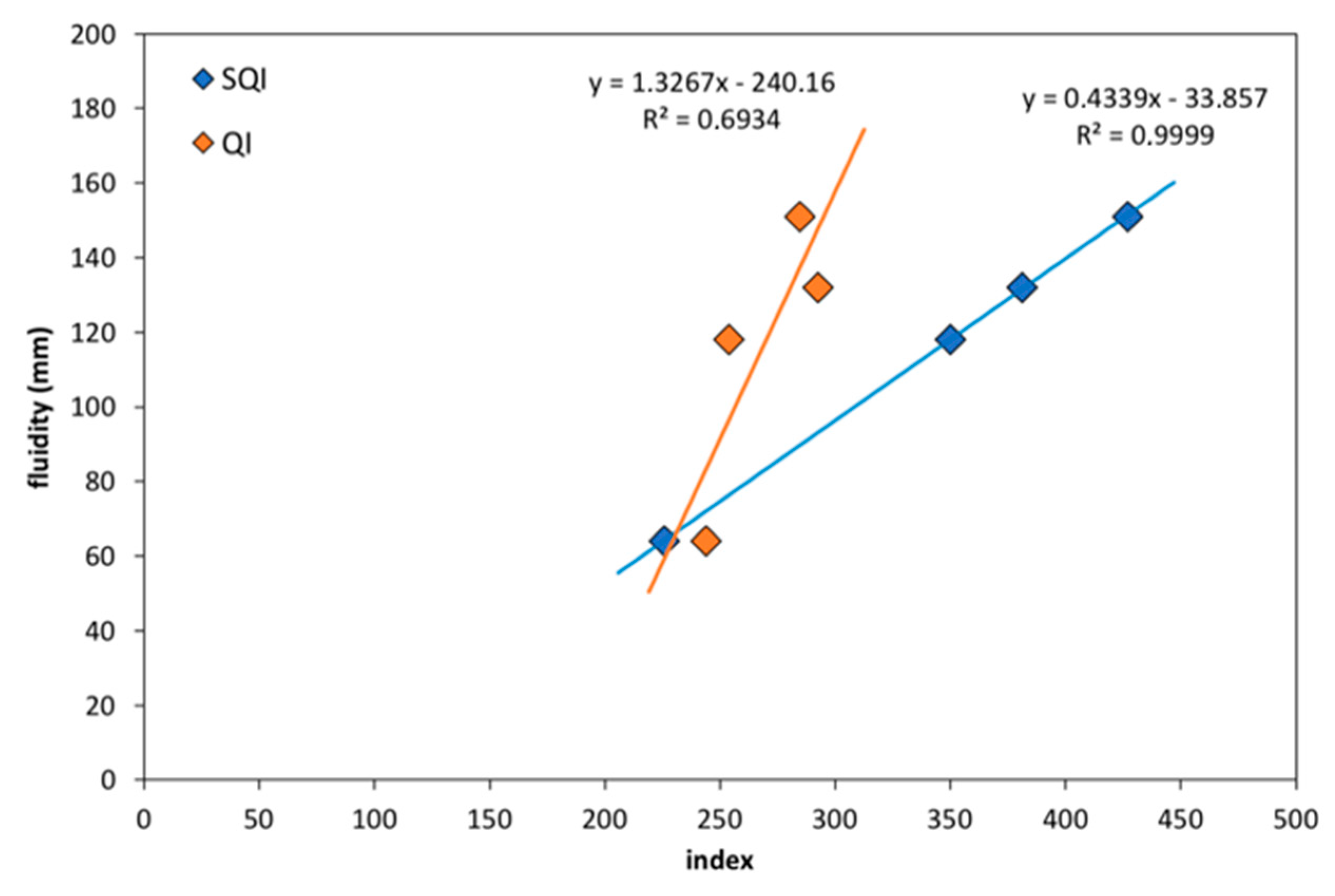

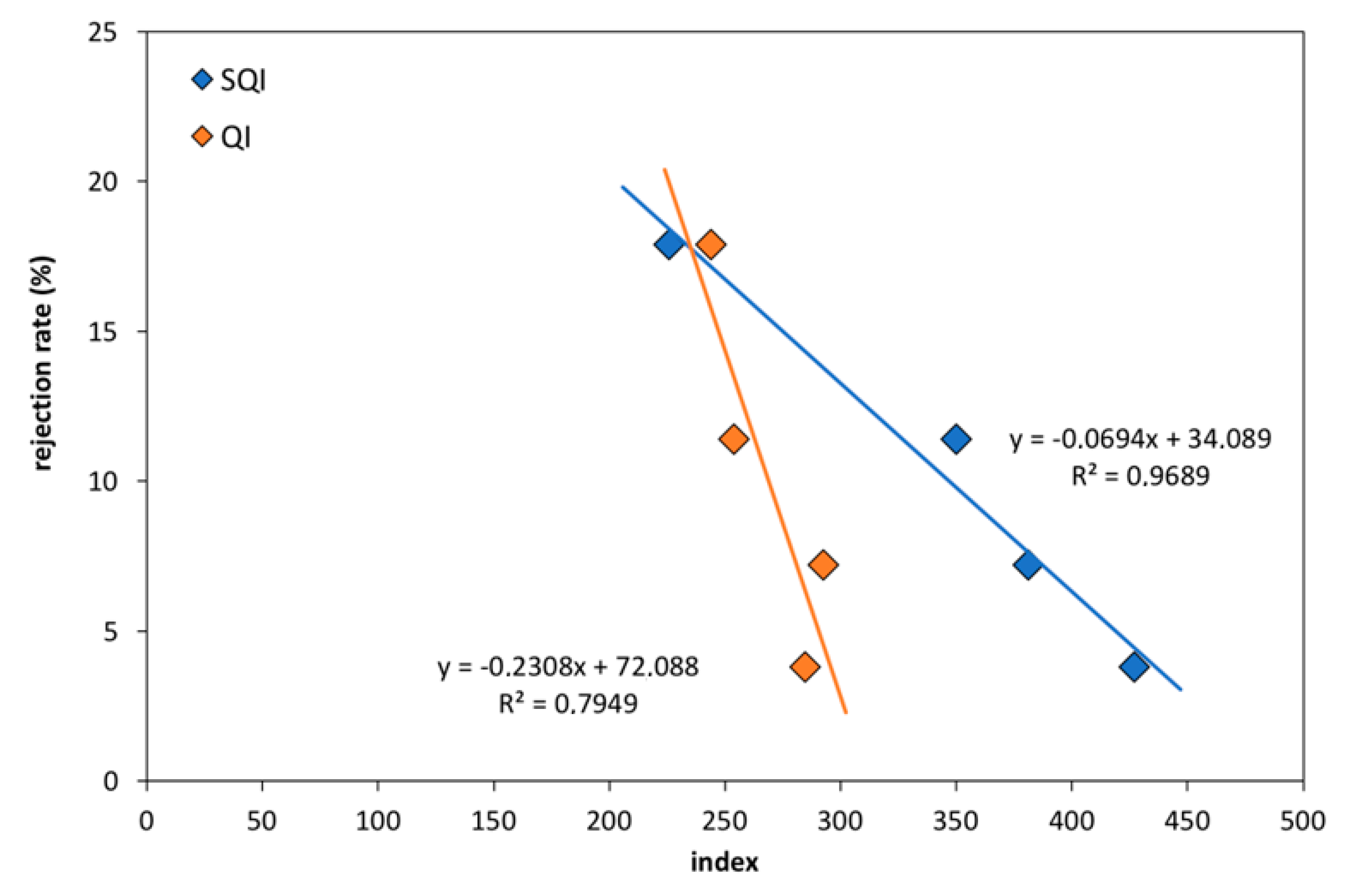
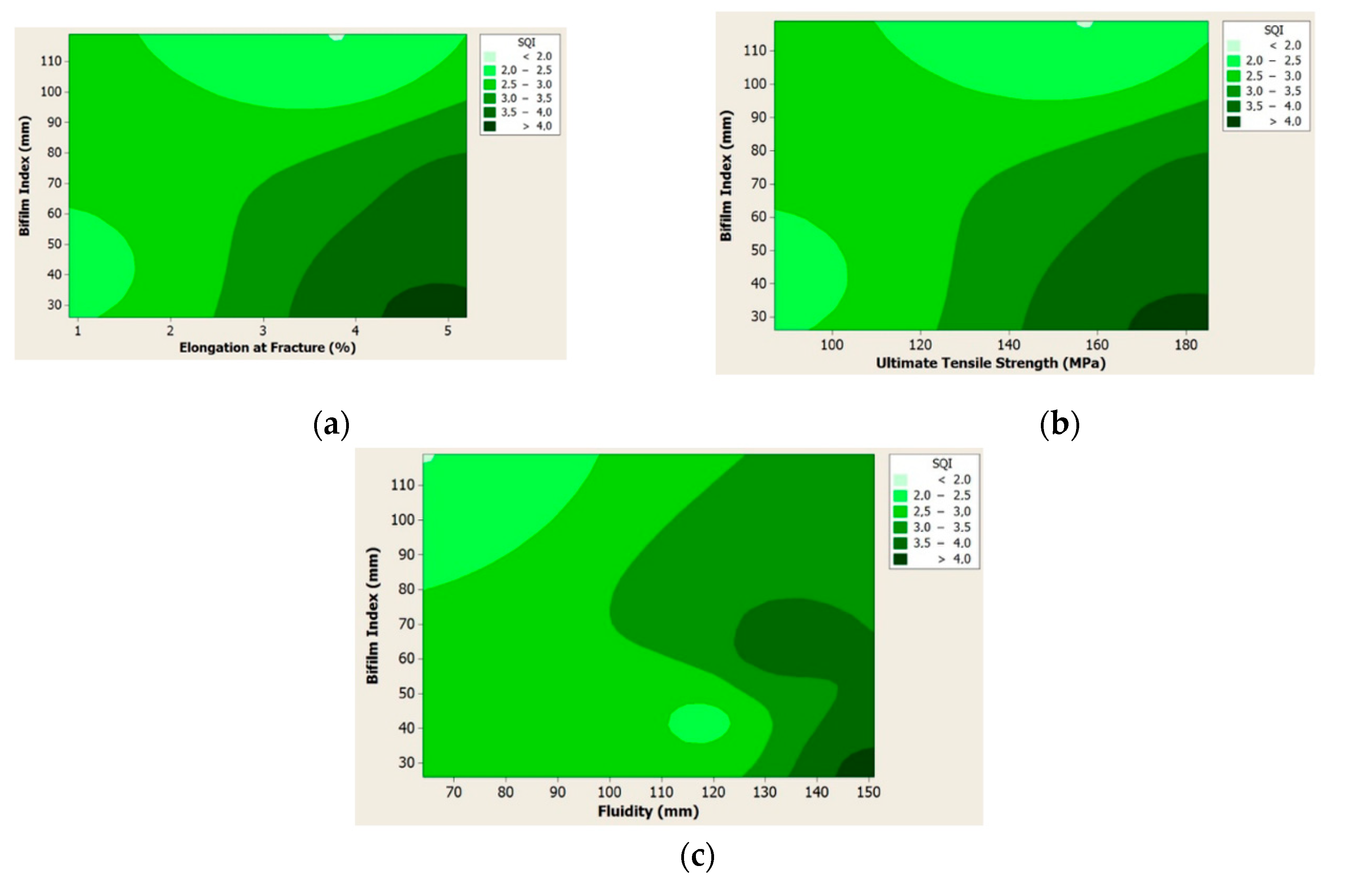
| Source | Si | Mg | Cu | Fe | Mn | Ti | Al |
|---|---|---|---|---|---|---|---|
| A | 7.13 | 0.389 | 0.023 | 0.135 | 0.002 | 0.114 | Remainder |
| B | 6.93 | 0.284 | 0.026 | 0.089 | 0.002 | 0.193 | Remainder |
| C | 6.77 | 0.298 | 0.016 | 0.083 | 0.002 | 0.177 | Remainder |
| D | 7.20 | 0.370 | 0.033 | 0.169 | 0.003 | 0.103 | Remainder |
© 2019 by the authors. Licensee MDPI, Basel, Switzerland. This article is an open access article distributed under the terms and conditions of the Creative Commons Attribution (CC BY) license (http://creativecommons.org/licenses/by/4.0/).
Share and Cite
Erzi, E.; Gürsoy, Ö.; Yüksel, Ç.; Colak, M.; Dispinar, D. Determination of Acceptable Quality Limit for Casting of A356 Aluminium Alloy: Supplier’s Quality Index (SQI). Metals 2019, 9, 957. https://doi.org/10.3390/met9090957
Erzi E, Gürsoy Ö, Yüksel Ç, Colak M, Dispinar D. Determination of Acceptable Quality Limit for Casting of A356 Aluminium Alloy: Supplier’s Quality Index (SQI). Metals. 2019; 9(9):957. https://doi.org/10.3390/met9090957
Chicago/Turabian StyleErzi, Eray, Özen Gürsoy, Çağlar Yüksel, Murat Colak, and Derya Dispinar. 2019. "Determination of Acceptable Quality Limit for Casting of A356 Aluminium Alloy: Supplier’s Quality Index (SQI)" Metals 9, no. 9: 957. https://doi.org/10.3390/met9090957
APA StyleErzi, E., Gürsoy, Ö., Yüksel, Ç., Colak, M., & Dispinar, D. (2019). Determination of Acceptable Quality Limit for Casting of A356 Aluminium Alloy: Supplier’s Quality Index (SQI). Metals, 9(9), 957. https://doi.org/10.3390/met9090957





